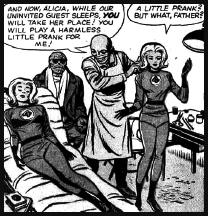1 We walk alike, we talk alike.… In The Fantastic Four #8 we are introduced to the blind sculptress Alicia Masters, who will become the Thing’s longtime girlfriend. We also learn that, as luck might have it, Alicia is somehow the exact double of Sue Storm, the Invisible Girl (with a wig on, of course)! If Silver Age comic books were to be believed, there would be an exact double of you on every other block.

2 How convenient! In The Fantastic Four #5, the Thing, the Human Torch, and Mister Fantastic are sent back in time. When they arrive, they look for disguises, and as luck might have it, they stumble upon two pirates arguing…over a large bag of stolen clothes. I wonder how long that took Stan Lee to figure out.
3 Dumb aliens. Here’s a genius plot to stop evil invaders. When Earth is threatened by the evil Skrulls, the Fantastic Four brilliantly decide to cut out pages from monster comics and give them to the Skrulls. The Skrulls are clearly not very intelligent, either, as they think that the comic illustrations are actually photographs, so they ship off from Earth to avoid these dangerous “monsters.” Now, as absurd as that is (and it is really absurd), the even crazier thing is that the Fantastic Four had just one issue earlier been to Monster Island. So if monsters were all they needed to convince the Skrulls not to invade, they had actual monsters they could have shown them and not had to cut out pages of a comic book. This is the best example of “Lee and Kirby did not think anyone but a kid would ever really read this comic, so why worry about the ending too much?”
4 The “Lincoln’s Mother” defense. The Fantastic Four #11 was a perfect indication of how different Marvel Comics was from DC Comics during the 1960s. Stan Lee knew how to hook an audience and this was a great example of that. You see, readers used to write in complaining about how useless the Invisible Girl was. Fans went as far as to call for her to be killed off. In #11, using the voices of the Thing (who is temporarily in human form as Ben Grimm) and Mister Fantastic (Reed Richards), Lee directly addresses the readers and defends the Invisible Girl. And what is the defense? Why, it is the Lincoln’s mother defense! You see, Abraham Lincoln once said that all that he was—all that he ever hoped to be—he owed to his mother. Therefore, if you are telling the story of Lincoln, you have to include his mother, right? Similarly, if it were not for the Invisible Girl’s inspiration to Mister Fantastic, Human Torch, and the Thing, there wouldn’t be a Fantastic Four! Yes, that is his actual argument. Reed then goes on to list the few times in the first ten issues that Sue was actually useful. It is amazing to see a fictional character have to be “defended” like that. Interestingly enough, even after that passionate defense, within a year Lee changed Sue’s powers to give her invisible force fields that eventually made her one of the most powerful members of the team.